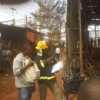News
The Nile’s record flooding adds urgency to regional cooperation

Serena Hotel Kigo was flooded for several months
The record amount of rainfall experienced in Eastern Africa region between October 2019 and April 2020, and the resultant devastation brought about by massive floods, have added a new sense of urgency to the need for greater cooperation among countries sharing river Nile.
Although the effects of the floods varied from country to country, on the whole, the damage wrought upon communities especially those near the lakes and the river, has been unprecedented.
According to data from the Nile Basin Initiative, water levels in lake Victoria rose by up to 1.4 metres in May 2020. This huge amounts of water submerged low lying areas all around Lake Victoria and destroyed property including hotels, farms and businesses.
The floods washed away crops, roads and cut off entire regions.
Kenya’s nation newspaper reported in May at the height of the record water levels, that more than 200 people had died due to the flooding especially around Kisumu port.
Thanks perhaps to the government’s swift action to protect Nalubaale and Kiira Hydro power dams by doubling the amount of water through the spill gates and preventing suds from moving toward the dams, the country’s power complex was saved from being wasted away.
The greatest economic damages, according to officials from Uganda’s Ministry of Water and Environment, happened downstream around lake Kyoga.
According to Dr. Zaroug Modathir, from the Nile Basin Initiative, the water levels around lake Kyoga rose by more than two metres compared to long term average.
And as expected, as the water flowed downstream, the impact of the floods were multiplied by the fact that both South Sudan and Sudan are generally flat and therefore the floods spread to a wider area and lasted longer than they did in Uganda.
“In South Sudan, entire villages were displaced and now they are battling the secondary effects of flooding which include an increase in incidences of water born diseases.
According to Modathir, Sudan was not spared by the floods, even though a huge amount of the water from the White Nile, reduces through evaporation.
“For the first time in many years, we experienced heavy rainfall in both Lake Victoria as well as Lake Tana region of Ethiopia. This exposed Khartoum, who is located at the confluence of both the Blue Nile and the White Nile to unprecedented floods around August 15, 2020.
Reports cited by Dr. Mudathir, indicated that 120 people were killed and more than three quarters of a million people in Sudan were displaced by the floods.
Even Egypt, for the first time in recent history experienced floods, according to Modathir, after the grand High Aswan dam failed to contain the huge volumes of water coming from both the Victoria and Tana.
“The water level in lake Nasser (the man made lake created by the High Aswan) rose by five metres,” says Modathir.
Arising from this devastation, have been louder calls from both experts as well as ordinary people for action from governments.
Most ordinary people have appealed to their national governments to rescue them from the quagmire.
But the more enlightened sections of society, have called for more regional approaches to tackling the problem of floods.
Dr. Modathir strongly argues that strengthening of basin wide cooperation arguing that that unity and cooperation is the only way to prevent or minimize the adverse effects of the floods.
“We must cooperate because we share the same basin and therefore it’s resources and challenges.
Through cooperation, Modathir argues, countries can make robust forecasting systems that would help neighbours plan better.
“Using a common platform, you can share data and exchange information about challenges and opportunities,”
And although the recent flood have brought more suffering than benefits, Modathir observes that with stronger cooperation and better forecasting, countries can make use of excess water for increased food and energy production.
In the East African Community, there are also growing calls for greater cooperation among member states in that are united under the Lake Victoria Basin Commission (LVBC).
At the height of floods in May, LVBC executive secretary Ali-Said Matano said his organization had proposed regional strategies for emergency and disaster preparedness to avert more deaths and destruction.
“We now have to take urgent action as over 200,000 people have already been displaced in Kenya and Uganda,” said Matano. He was quoted as saying during virtual meeting that was attended by transboundary water experts from Kenya, Uganda and Tanzania.
On its part, the Nile Basin Initiative is expediting the development of the Nike Basin river flow forecasting system.
According to Modathir, NBI will establish water level monitors at 8 locations along the river to deliver real-time data which can be disseminated to member countries for planning purposes.
Although efforts by some countries to put in place a shared plan for managing the Nile Basin water and other resources has met resistance from some countries like Egypt, Modathir believes that the record floods might of trigger a a change of mind and perhaps become a turning point for stronger cooperation, as countries finally realized there are worse effects of suffering alone than working together.
Comments


























